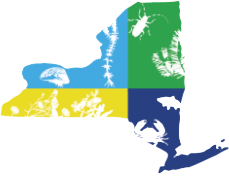Ann Arbor, MI – The U.S. Environmental Protection Agency registered a sea lamprey mating pheromone, 3kPZS, as the first ever vertebrate pheromone biopesticide in late December, 2015. Like an alluring perfume, the mating pheromone is a scent released by male sea lampreys to lure females onto nesting sites. Research and development of the mating pheromone was funded by the Great Lakes Fishery Commission, with additional support from the Great Lakes Restoration Initiative, in collaboration with federal government, university, and private industry partners.
Since the 1990s, scientists have been researching the use of pheromones – natural odors used by sea lampreys to communicate – to manipulate sea lamprey behaviors. The newly registered mating pheromone has been used as bait in traps that collect and remove adult sea lampreys before they have a chance to spawn. Other sea lamprey pheromones are also being explored for use in sea lamprey control as attractants and repellents. Although “pesticide” may be part of the name, many biopesticides – such as the sea lamprey mating pheromone – naturally occur in the environment and are extremely potent, but not lethal, substances.
“The Great Lakes Fishery Commission is very excited about this accomplishment,” said Dr. Robert Hecky, chair of the commission. “U.S. EPA registration of the sea lamprey mating pheromone opens the door for use of the pheromone in the commission’s sea lamprey control program, which protects Great Lakes fisheries from destruction caused by invasive sea lampreys.” Dr. Hecky also emphasized the critical role of partners. “This achievement has been many years in the making and could not have occurred without the excellent work of our collaborators at the U.S. Geological Survey, Michigan State University, and Bridge Organics Company.”
Dr. Suzette Kimball, USGS director, praised registration of the sea lamprey mating pheromone as “a milestone for control of invasive species and protection of natural biodiversity.” She further emphasized the significance of this event saying, “Registration is the culmination of great leadership and innovation among the Great Lakes Fishery Commission, the USGS, and our university and private-sector partners. Development of the sea lamprey mating pheromone is exactly the type of cuttingedge research that places each partner at the forefront of science.”
The commission also lauded the U.S. EPA’s leadership and noted that this action provides a path for additional chemosensory compounds to be registered as a means to control other vertebrate species. Moreover, this registration marks the first joint review with Canada of a biopesticide through the North American Free Trade Agreement. The Health Canada Pest Management Regulatory Agency is in the process of registering the mating pheromone for use in Canada.
Since invading the Great Lakes in the 1800s and early 1900s, sea lampreys – parasitic, jawless vertebrates that feed on the blood and body fluids of other fish – have caused enormous ecological and economic damage. To combat this menace, the commission coordinates an integrated sea lamprey control program implemented by the U.S. Fish and Wildlife Service and Fisheries and Oceans Canada that combines lampricides, barriers, and traps. The control program is remarkably successful: sea lamprey populations in most areas of the Great Lakes have been reduced by 90 percent of their historical highs.
“Our research has shown that the sea lamprey mating pheromone holds great promise for the sea lamprey control program,” explained Dr. Weiming Li, professor at Michigan State University through the commission’s Partnership for Ecosystem Research and Management. “With a large-scale field trial, we demonstrated that pheromone baits can increase trapping efficiencies by up to 53 percent and baited traps can capture up to two times the sea lampreys that un-baited traps can.” While initial trials were completed with pheromone derived from live male sea lampreys, the researchers also discovered the molecular structure of the mating pheromone and contracted with Bridge Organics, a private company in Michigan, to manufacture a synthetic version.
Bridge Organics was a key partner in both the development of the synthesized mating pheromone and the U.S. EPA registration process. Like using a blueprint to construct a high-tech building, Bridge Organics used the molecular structure provided by the scientists to construct the exact pheromone molecule from scratch. “When the commission contacted us to synthesize the sea lamprey mating pheromone, we were excited by the scientific challenge,” recalled Dr. Ed Hessler, president of Bridge Organics. “Our company is proud to have developed the chemistry to synthesize the mating pheromone and to have coordinated testing of the compound during the registration process.”
The U.S. EPA registration covers both the synthesized male mating pheromone as well as the mixture of synthesized pheromone and solvents used in field applications. The U.S. FWS holds the registration for 3kPZS and is the entity licensed to apply this in the field when deemed appropriate. The mating pheromone is classified as a biopesticide, a designation that includes any naturally occurring substance that controls pests. Other registered biopesticides include the pheromone disparlure, which is used to detect and control small infestations of gypsy moths. Registration of the sea lamprey mating pheromone is the first for a vertebrate biopesticide.
Once registered in both the United States and Canada, the sea lamprey mating pheromone can be used to help control invasive sea lampreys in U.S. and Canadian waters throughout the Great Lakes. With each additional tool in the sea lamprey control arsenal, the commission improves its ability to protect the $7 billion fishery.
Credit: Andrea Miehls USGS


